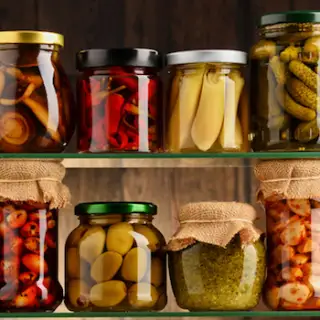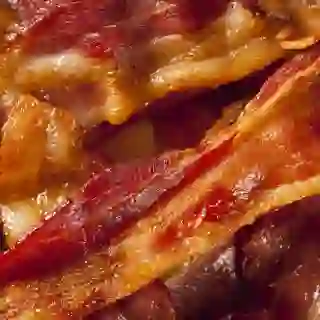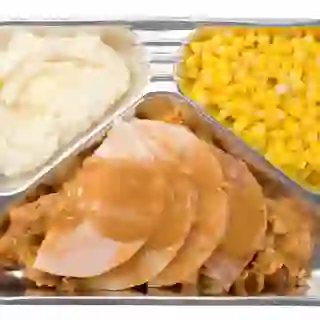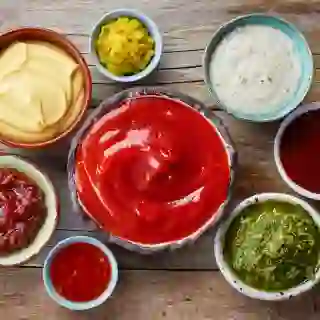
If you struggle with high blood pressure, you know the constant battle to watch your diet in order to improve your health. “The foods you eat—and don’t eat—very much factor into your blood pressure,” says Kathy McManus, R.D., director of the department of nutrition at Brigham and Women’s Hospital in Boston. For instance, high sodium foods disrupt the balance of water in your body, which strains your blood vessels and causes blood pressure to rise. Looking for more tips on what to steer clear of? Start here.

Chicken
We know, what could possibly be wrong with this staple of family dinners and lunchtime sandwiches across America? But chicken, even before you put anything on it, is often injected with saltwater solutions during processing, making it a hidden source of sodium. In fact, chicken sits eighth on the CDC’s list of top 10 sources of sodium. One 4 oz boneless, skinless chicken breast can contain anywhere from 40 mg to 330 mg of sodium. Check the label: The sodium content should be 70 mg a serving or less.

Bacon and Deli Meat
Roast beef, ham, bacon—it doesn’t really matter which deli counter item you choose, they’re all loaded with sodium. “Even the ‘low salt’ ones are pretty high in sodium,” says McManus. Just six thin slices of deli meat can contain half of your recommended daily sodium intake, according to the American Heart Association (AHA), which uses 1,500 mg as the ideal daily amount (lower than other guidelines suggesting 2,300 mg). When you consider two lowly strips of bacon weighs in at 330 mg of sodium, you can see the problem.

Sandwiches
That’s a pretty broad category, for sure. But the truth is, the majority of classic sandwich components are not friendly to your blood pressure. “For instance, an average turkey sandwich on whole-wheat bread with mayo, a pickle, and a slice of cheddar comes out to about 1,315 mg of sodium,” notes Desiree Nielsen, R.D., author of Eat More Plants Cookbook. The good news: You don’t have to swear off sammies for good, but make them yourself and load them with fresh veggies (hold the mayo!).

Bread
True fact: Yeast breads (including rolls, bagels, flour tortillas and wraps) rank first as the food item that contributes the most sodium to American diets, according to the AHA. For some perspective, just one slice of Whole Foods’ Organic 100% Whole Wheat Sandwich Bread contains the sodium equivalent of 22 potato chips. When shopping, look for loaves with 5% daily value (DV) or less for sodium. (A DV of 20% or more is high.)

Canned Soup
Thanks to modern techniques, we no longer need salt to preserve canned goods. “But since food can lose its flavor when it’s cooked to sterilization and stored in a can, it’s common for manufacturers to still add a lot of salt,” says Nielsen. Canned soups contain anywhere from 100 mg to 940 mg of sodium per cup. Look for ones labeled unsalted, sodium-free or low sodium. (Low sodium means 140 mg of sodium or less per serving.) “And if it’s a broth-based soup, you can also dilute it with a low-sodium broth,” says McManus.

Alcohol
Consuming seven to 13 alcoholic beverages a week can substantially raise your risk of high blood pressure, according to recent research. “It’s thought that alcohol in this amount may stimulate the sympathetic nervous system, which ups cortisol levels and creates an imbalance in the vascular inflammatory system,” says Kimberly Parks, D.O., an integrative cardiologist and assistant professor of medicine at Harvard Medical School in Boston.

Sugar-Sweetened Beverages
It’s no shock that soda’s full of empty calories, but it is surprising how little it takes to impact blood pressure. A study in The American Journal of Clinical Nutrition found that just one sugar-sweetened beverage a day can bump your numbers higher. Combine that with another study in Nutrients that found reducing added sugar intake by just 2.3 teaspoons can lead to a drop hypertension readings and you have a legit reason for steering clear of the sweet stuff. (PS: A 12-ounce can of cola contains more than four times that amount of sugar.)

Restaurant Meals
Look, no one’s telling you to skip your anniversary dinner or holiday party. But you’re better off saving eating out for special occasions, since 71% of people’s sodium intake comes from foods eating outside of the home, according to a report in Circulation. Another study found that fast-food eaters consume six times more sodium than they think. If you’re eating out, follow these tips: Order the lunch portion; don’t order items that are pickled, cured, or smoked; skip the soy sauce; and ask for dressing on the side.

Frozen Dinners
So nice to heat and eat on your sofa, but you know what? These dishes are usually salt bombs. “Frozen dinners and pizzas are very high in sodium,” says McManus. “Even if you’re buying a low-calorie frozen meal from a ‘healthy’ brand, often when they reduce the fat content, they also dump in sodium to add flavor.” Before you buy, check the label. If the sodium content of the entree is 600 mg or less, it’s OK as a once-in-a-while meal.

Sauces and Condiments
“My patients will often say that because they don’t use table salt, they must not be getting much sodium—they don’t realize that sodium hides out in the condiments,” says Parks. Packaged sauces and dressings are also often high in saturated fat and added sugar. When possible, DIY is always healthier for condiments. And watch your serving size: Use a tablespoon or less per serving, and opt for low-sodium and no-added-sugar versions. Even better, swap hot sauce for red pepper flakes and mayo for hummus or avocado.

Pizza
Just one slice of cheese and pepperoni pizza can contain more than half of your daily recommended dietary sodium. Heck, even if you go for the veggie version, you’re still knocking your blood pressure. For example, one slice of Domino’s Deep-Dish Veggie Pizza contains 616 mg of sodium, while a slice of Pizza Hut Veggie Lovers Pan Pizza clocks 512 mg. (And also: Who eats just one slice?)

Salty Snacks
It’s a big “no duh” that snack foods like chips, popcorn, pretzels, snack mixes, and crackers are high in sodium. But what you might not know is that chips or crackers labeled “reduced sodium” aren’t necessarily low in sodium. It simply means that the bag or box in your hands has at least 25% less sodium than the original variety. Better to opt for “low sodium” snacks that offer 140 mg of sodium or less per serving.
- Sodium and Chicken (1): Centers for Disease Control and Prevention. (2021). “Top 10 Sources of Sodium.” cdc.gov/salt/sources.htm
- Sodium and Chicken (2): Centers for Disease Control and Prevention. (2017). “Get the Facts: Sources of Sodium in Your Diet.” https://www.cdc.gov/salt/sources.htm
- Deli Meat and Sodium: American Heart Association. (2018). “The Salty Six Infographic.” heart.org/en/healthy-living/healthy-eating/eat-smart/sodium/salty-six-infographic
- Sodium and Bacon: U.S. Department of Agriculture. (2019). “Bacon.” fdc.nal.usda.gov/fdc-app.html#/food-details/511244/nutrients
- What’s Considered “Low Sodium”: U.S. Food and Drug Association. (2018). “Use the Nutrition Facts Label to Reduce Your Intake of Sodium in Your Diet.” fda.gov/food/nutrition-education-resources-materials/use-nutrition-facts-label-reduce-your-intake-sodium-your-diet
- Sodium and Bread: Center for Science in the Public Interest. (2017). “Sodium Levels Vary Widely in Bread.” cspinet.org/news/sodium-levels-vary-widely-bread-20170516
- Alcohol and BP: Journal of the American College of Cardiology. (2019). “Moderate Alcohol Consumption Linked with High Blood Pressure.” onlinejacc.org/content/73/9_Supplement_2/12
- Soda and Blood Pressure: American Journal of Clinical Nutrition. (2015). “Sugar-Sweetened Beverage Consumption and Incident Hypertension: A Systematic Review and Meta-Analysis of Prospective Cohorts.” academic.oup.com/ajcn/article/102/4/914/4564590
- Reducing Added Sugar: Nutrients. (2019). “Added Sugar Intake is Associated with Blood Pressure in Older Females.” mdpi.com/2072-6643/11/9/2060/htm
- Restaurant and Sodium: Circulation. (2017). “Sources of Sodium in US Adults From 3 Geographic Regions.” ahajournals.org/doi/full/10.1161/circulationaha.116.024446
- Fast Food and Sodium: Appetite. (2017). “Consumer Underestimation of Sodium in Fast Food Restaurant Meals.” sciencedirect.com/science/article/abs/pii/S0195666317302659
- Sodium in Frozen Meals: Cleveland Clinic. (2019). “Sodium-Controlled Diet.” https://my.clevelandclinic.org/health/articles/15426-sodium-controlled-diet
- Condiments: American Heart Association. (2018). “Healthier Condiments.” heart.org/en/healthy-living/healthy-eating/cooking-skills/cooking/healthier-condiments